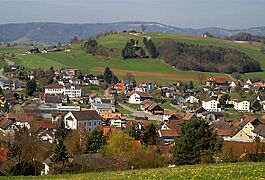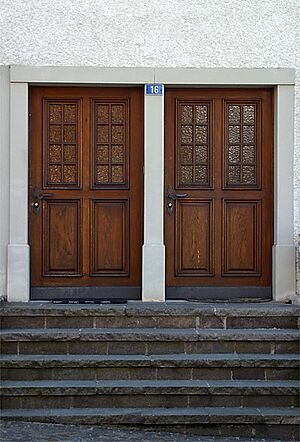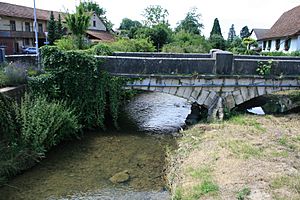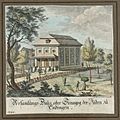Endingen, Switzerland facts for kids
Quick facts for kids
Endingen
|
||
|---|---|---|
 |
||
|
||
| Country | Switzerland | |
| Canton | Aargau | |
| District | Zurzach | |
| Area | ||
| • Total | 11.91 km2 (4.60 sq mi) | |
| Elevation | 383 m (1,257 ft) | |
| Population
(Dec 2020 )
|
||
| • Total | 2,597 | |
| • Density | 218.05/km2 (564.8/sq mi) | |
| Postal code |
5304
|
|
| Surrounded by | Baldingen, Lengnau, Obersiggenthal, Unterendingen, Würenlingen | |
Endingen is a town in the canton of Aargau, Switzerland. It's located in the Zurzach district.
This town has a special history. In the 18th and 19th centuries, Endingen was one of the few places in Switzerland where Jewish people were allowed to live. Because of this, some old houses in Endingen have two separate doors: one for Jewish families and one for Christian families.
Endingen is also unique because it doesn't have a Christian church. Instead, it has a synagogue, which is a Jewish house of worship. The synagogue and the Jewish cemetery in Endingen are very important. They are listed as a national heritage site.
On January 1, 2014, the nearby town of Unterendingen joined with Endingen to form one larger municipality.
Contents
Endingen's Past: A Look at Its History
People have lived in the area around Endingen for a very long time. Tools and items from the Neolithic (New Stone Age) and Bronze Age have been found here. Later, in the Early Middle Ages, a group called the Alamanni settled in this region.
The modern town of Endingen was first mentioned in records in the year 798. Back then, it was called Entingas. Until 1945, it was known as Oberendingen. For many centuries, different powerful families and religious groups owned land in the village. By the 13th century, the Habsburgs ruled the area. In 1415, the Swiss Confederation took control. Endingen then became part of the larger region managed by the bailiff of Baden.
Why Endingen Was Special for Jewish Families
In 1678, a special rule was made. It allowed Jewish people to settle in the Surb valley. After 1776, they were only allowed to live in Endingen and Lengnau. This led to many Jewish families moving to Endingen.
This immigration changed the town's look and feel. Endingen never built a Christian church. Christians living there went to churches in nearby villages. Jewish and Christian families often lived in the same buildings. By the mid-1800s, Endingen had about 2,000 people. About half were Jewish and half were Christian.
Jewish residents were generally treated well. They managed their own community and had their own school. However, they were mostly allowed to work only in trade. Houses were built with two entrances: one for Jewish families and one for Christian families. It wasn't until 1876 that Jewish people in Switzerland gained full equal rights. By 1920, most Jewish residents had left Endingen.
The only place of worship in Endingen is the synagogue. It was first built in 1764 and then rebuilt in 1852.
The Plum War of 1802
In 1798, France invaded Switzerland and created a new government called the Helvetic Republic. This new government wanted to make Switzerland more modern and fair. Some reformers tried to give Jewish people more rights.
However, many Swiss people did not like these big changes. The idea of giving more rights to Jewish people became a big argument. In 1802, some people revolted. They attacked and looted the Jewish villages of Endingen and Lengnau.
The French leader, Napoleon Bonaparte, needed his soldiers for other wars. He couldn't send enough troops to stop the unrest in Switzerland. So, in 1803, he created a compromise called the Act of Mediation. This act tried to balance the old ways with the new ideas. One part of this compromise was that Jewish people did not get any new rights at that time.
Endingen's Geography and Landscape
Endingen covers an area of about 8.46 square kilometers (3.27 square miles). Almost half of this area, about 44.9%, is used for farming. Another large part, about 45.4%, is covered by forests.
About 9.1% of the land is built up with houses and roads. A very small part, about 0.4%, consists of rivers or lakes. The town is located in the Surb river valley. Endingen is a haufendorf village. This means it's an unplanned village with buildings packed closely around a central area. It also includes a smaller settlement called Loohof.
Endingen's Coat of Arms
The coat of arms for Endingen is described as: Per pale Argent a Fleur-de-lis mediated Gules and Or. This means it has two halves. One half is silver with a red fleur-de-lis (a stylized lily). The other half is gold.
Who Lives in Endingen?
Endingen has a population of about 2,600 people. As of June 2009, about 14.9% of the people living in Endingen were from other countries. Over ten years, from 1997 to 2007, the population grew by about 10.2%.
Most people in Endingen speak German, about 92.9%. The next most common language is Albanian, spoken by 2.4% of the population. French is spoken by 1.2%.
The age groups in Endingen are spread out. About 12.5% of the population are children aged 0-9. Teenagers aged 10-19 make up about 11.8%. Adults aged 20-59 make up a large portion, around 54.2%. Senior citizens, aged 60 and older, make up about 21.5% of the population.
In 2008, about 46% of the homes in Endingen were single-family houses. There were no empty apartments at that time, meaning all available homes were occupied.
Endingen's Population Over Time
This chart shows how the population of Endingen and Unterendingen changed over the years:

Important Heritage Sites
The Jewish cemetery on Hauptstrasse and the Synagogue on Hintersieg are very important. They are listed as Swiss heritage sites of national significance. This means they are protected because of their historical and cultural value.
Both the entire village of Unterendingen and the entire village of Endingen are recognized as part of the Inventory of Swiss Heritage Sites. This helps preserve their unique character.
Endingen's Economy and Jobs
In 2007, Endingen had a low unemployment rate of 1.44%. This means most people who wanted to work had jobs.
The economy of Endingen is divided into three main parts:
- Primary sector: This includes jobs like farming. In 2005, about 92 people worked in this sector.
- Secondary sector: This includes jobs in manufacturing and construction. About 184 people worked in this sector.
- Tertiary sector: This includes jobs in services, like shops, offices, and healthcare. About 263 people worked in this sector.
In 2000, many people who lived in Endingen worked outside the town. About 73.7% of residents commuted to jobs elsewhere. However, 239 people came into Endingen for work. About 12.3% of workers used public transportation, and 52.6% drove their own cars to work.
Religion in Endingen
According to the 2000 census, about 51.6% of the population in Endingen were Roman Catholic. About 31.9% belonged to the Swiss Reformed Church. A small number, about 0.23%, were part of the Christian Catholic faith.
Education in Endingen
Switzerland is known for its good education system. In Endingen, about 82.3% of adults aged 25 to 64 have completed higher education. This means they finished either advanced secondary school or went to a university or college.
In the 2008/2009 school year, there were 148 students attending primary school in Endingen. There were also 297 students attending university or college-level schooling who lived in the municipality.
Images for kids
See also
 In Spanish: Endingen para niños
In Spanish: Endingen para niños










